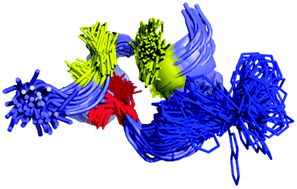Protonation/deprotonation effects on the stability of the Trp-cage miniprotein†
Abstract
The Trp-cage miniprotein is a 20

- This article is part of the themed collection: Physical Foundations of Protein Folding
* Corresponding authors
a
Department of Physics, Applied Physics and Astronomy, Rensselaer Polytechnic Institute, Troy, NY 12180, USA
E-mail:
jimenc@rpi.edu
b
Department of Biology, Rensselaer Polytechnic Institute, Troy, NY 12180, USA
E-mail:
makhag@rpi.edu
c
Department of Physics, Applied Physics and Astronomy, and Center for Biotechnology and Interdisciplinary Studies, Rensselaer Polytechnic Institute, Troy, NY 12180, USA
E-mail:
angel@rpi.edu
The Trp-cage miniprotein is a 20

 Please wait while we load your content...
Something went wrong. Try again?
Please wait while we load your content...
Something went wrong. Try again?
C. A. Jimenez-Cruz, G. I. Makhatadze and A. E. Garcia, Phys. Chem. Chem. Phys., 2011, 13, 17056 DOI: 10.1039/C1CP21193E
To request permission to reproduce material from this article, please go to the Copyright Clearance Center request page.
If you are an author contributing to an RSC publication, you do not need to request permission provided correct acknowledgement is given.
If you are the author of this article, you do not need to request permission to reproduce figures and diagrams provided correct acknowledgement is given. If you want to reproduce the whole article in a third-party publication (excluding your thesis/dissertation for which permission is not required) please go to the Copyright Clearance Center request page.
Read more about how to correctly acknowledge RSC content.
 Fetching data from CrossRef.
Fetching data from CrossRef.
This may take some time to load.
Loading related content
